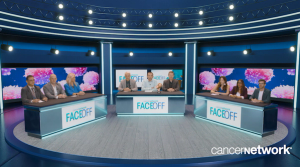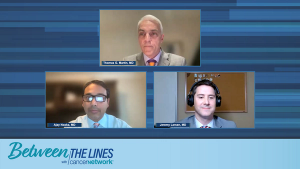Articles by Thomas G. Martin, MD
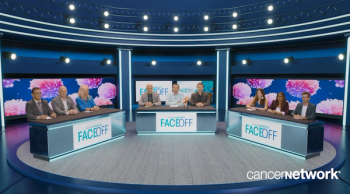
Clinical Scenario: Implementation of Bispecific Therapy for Relapsed Refractory Multiple Myeloma in a Community Center
ByAjai Chari, MD,Thomas G. Martin, MD,Jens Hillengass, MD, PhD ,Beth Faiman PhD, MSN, APN-BC,BMTCN, AOCN, FAAN, FAPO ,Louis Williams, MD,Shebli Atrash, MD ,Donna Catamero, ANP-BC, OCN, CCRC,Cesar Rodriguez Valdes, MD ,Shambavi Richard, MD Panelists discuss how community centers can effectively implement bispecific antibody therapy for patients with relapsed/refractory multiple myeloma, addressing challenges such as staff training, patient monitoring, and managing potential adverse events in a non-academic setting.

Clinical Scenario: A 58-Year Old Woman with Relapsed Refractory Mutiple Myeloma, post-ASCT, MRD-negative, on Bispecific Therapy
ByAjai Chari, MD,Thomas G. Martin, MD,Jens Hillengass, MD, PhD ,Beth Faiman PhD, MSN, APN-BC,BMTCN, AOCN, FAAN, FAPO ,Louis Williams, MD,Shebli Atrash, MD ,Donna Catamero, ANP-BC, OCN, CCRC,Cesar Rodriguez Valdes, MD ,Shambavi Richard, MD Panelists discuss how to approach treatment decisions and management strategies for a 58-year-old woman with relapsed/refractory multiple myeloma who is post-autologous stem cell transplant, MRD-negative, and currently receiving bispecific antibody therapy, considering factors such as prior treatments, response duration, and long-term treatment goals.

Dosing Interval and Considerations for Bispecifics Combination in Relapsed Refractory Multiple Myeloma
ByAjai Chari, MD,Thomas G. Martin, MD,Jens Hillengass, MD, PhD ,Beth Faiman PhD, MSN, APN-BC,BMTCN, AOCN, FAAN, FAPO ,Louis Williams, MD,Shebli Atrash, MD ,Donna Catamero, ANP-BC, OCN, CCRC,Cesar Rodriguez Valdes, MD ,Shambavi Richard, MD Panelists discuss how optimizing dosing intervals and carefully considering combination strategies for bispecific antibodies in relapsed/refractory multiple myeloma could enhance treatment efficacy while managing toxicities and improving patient quality of life.

Sequencing Therapies in Relapsed Refractory Multiple Myeloma: Bispecifics and CAR T-Cell Therapies
ByAjai Chari, MD,Thomas G. Martin, MD,Jens Hillengass, MD, PhD ,Beth Faiman PhD, MSN, APN-BC,BMTCN, AOCN, FAAN, FAPO ,Louis Williams, MD,Shebli Atrash, MD ,Donna Catamero, ANP-BC, OCN, CCRC,Cesar Rodriguez Valdes, MD ,Shambavi Richard, MD Panelists discuss how the optimal sequencing of bispecific antibodies and CAR T-cell therapies in relapsed/refractory multiple myeloma could maximize treatment efficacy and improve patient outcomes in this challenging disease setting.

OPTec: Outpatient Step Up Administration of Teclistamab: Implications in Real-World Practice
ByAjai Chari, MD,Thomas G. Martin, MD,Jens Hillengass, MD, PhD ,Beth Faiman PhD, MSN, APN-BC,BMTCN, AOCN, FAAN, FAPO ,Louis Williams, MD,Shebli Atrash, MD ,Donna Catamero, ANP-BC, OCN, CCRC,Cesar Rodriguez Valdes, MD ,Shambavi Richard, MD Panelists discuss how the OPTec study, which explores outpatient step-up administration of teclistamab, could impact real-world practice by potentially improving patient convenience and reducing healthcare resource utilization in the treatment of multiple myeloma.

Prophylactic Tocilizumab in MajesTEC-1 for the Reduction of CRS
ByAjai Chari, MD,Thomas G. Martin, MD,Jens Hillengass, MD, PhD ,Beth Faiman PhD, MSN, APN-BC,BMTCN, AOCN, FAAN, FAPO ,Louis Williams, MD,Shebli Atrash, MD ,Donna Catamero, ANP-BC, OCN, CCRC,Cesar Rodriguez Valdes, MD ,Shambavi Richard, MD Panelists discuss how prophylactic use of tocilizumab in the MajesTEC-1 trial may reduce the incidence and severity of cytokine release syndrome (CRS) in patients receiving bispecific antibody therapy for multiple myeloma, potentially improving treatment safety and tolerability.

Bispecific Antibody Combinations In Relapsed Refractory Multiple Myeloma: RedirecTT-1 Follow-Up
ByAjai Chari, MD,Thomas G. Martin, MD,Jens Hillengass, MD, PhD ,Beth Faiman PhD, MSN, APN-BC,BMTCN, AOCN, FAAN, FAPO ,Louis Williams, MD,Shebli Atrash, MD ,Donna Catamero, ANP-BC, OCN, CCRC,Cesar Rodriguez Valdes, MD ,Shambavi Richard, MD Panelists discuss how the follow-up results from the RedirecTT-1 study provide insights into the long-term efficacy and safety of bispecific antibody combinations in treating relapsed/refractory multiple myeloma, potentially shaping future treatment approaches for this challenging disease.
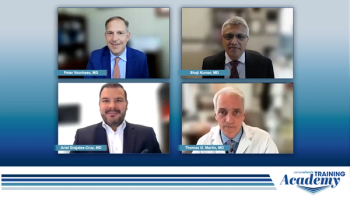
Experts on multiple myeloma outline current challenges in determining the optimal treatment strategy for patients with relapsed/refractory disease who are eligible for bispecifics and CAR T-cell therapy.

The panel concludes its discussion with key takeaways on unmet needs and evolving treatment paradigms in relapsed/refractory multiple myeloma.

Bispecific Antibody Combinations In Relapsed Refractory Multiple Myeloma: TRIMM-2 Study
ByAjai Chari, MD,Thomas G. Martin, MD,Jens Hillengass, MD, PhD ,Beth Faiman PhD, MSN, APN-BC,BMTCN, AOCN, FAAN, FAPO ,Louis Williams, MD,Shebli Atrash, MD ,Donna Catamero, ANP-BC, OCN, CCRC,Cesar Rodriguez Valdes, MD ,Shambavi Richard, MD Panelists discuss how the TRIMM-2 study explores the potential of combining bispecific antibodies to enhance treatment efficacy in patients with relapsed/refractory multiple myeloma, potentially offering a novel therapeutic strategy for this difficult-to-treat condition.

Talquetamab, a GPRC5DxCD3 bispecific antibody (BsAb), for Relapsed Refractory Multiple Myeloma: MonumenTAL-1 Data and Implications
ByAjai Chari, MD,Thomas G. Martin, MD,Jens Hillengass, MD, PhD ,Beth Faiman PhD, MSN, APN-BC,BMTCN, AOCN, FAAN, FAPO ,Louis Williams, MD,Shebli Atrash, MD ,Donna Catamero, ANP-BC, OCN, CCRC,Cesar Rodriguez Valdes, MD ,Shambavi Richard, MD Panelists discuss how Talquetamab, a novel GPRC5DxCD3 bispecific antibody, shows promising results in treating relapsed/refractory multiple myeloma based on the MonumenTAL-1 trial data, potentially offering a new therapeutic option for this challenging patient population.

Experts on multiple myeloma outline current challenges in determining the optimal treatment strategy for patients with relapsed/refractory disease who are eligible for bispecifics and CAR T-cell therapy.

Shaji Kumar, MD, reviews data from cohort C of CARTITUDE-2 and a real-world study evaluating ide-cel in patients with relapsed/refractory multiple myeloma.

Following the presentation of a case of a patient with relapsed/refractory multiple myeloma, the expert panel reviews treatment options.

Shaji Kumar, MD, reviews data from cohort C of CARTITUDE-2 and a real-world study evaluating ide-cel in patients with relapsed/refractory multiple myeloma.

The panel discusses how they approach treatment selection and sequencing for patients with relapsed/refractory multiple myeloma.

Shaji Kumar, MD, presents the case of a 70-year-old patient with relapsed/refractory multiple myeloma who received CAR T-cell therapy.

Thomas G. Martin, MD, reviews findings from a pooled analysis from MagnetisMM that evaluated elranatamab in patients with relapsed/refractory MM who received prior BCMA-directed therapies.
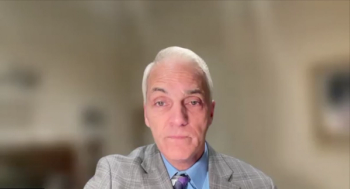
Adding bortezomib to Isa-Rd triplet therapy enhanced MRD-negative responses in patients with transplant-ineligible multiple myeloma.

Isatuximab plus VRd triplet therapy did not significantly increase toxicity in patients with transplant-ineligible multiple myeloma in the IMROZ trial.

Isatuximab quadruplet therapy for patients with multiple myeloma prolonged progression-free survival when compared with VRd triplet therapy.

Focusing on treatment paradigms for patients with relapsed/refractory multiple myeloma, the expert panel discusses the role of BCMA-targeted bispecifics and how they might consider sequencing therapies.

Following the presentation of a case of a patient with multiple myeloma, the panel have a roundtable discussion on how to approach treatment.

A panel of myeloma specialists review the case of a 67-year-old patient with multiple myeloma (MM) who received a bispecific antibody.
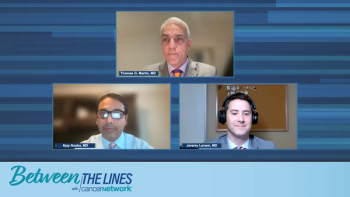
Thomas Martin, MD; Ajay Nooka, MD; and Jeremy Larsen, MD, share closing thoughts on the evolving landscape of cytokine release syndrome management in relapsed/refractory multiple myeloma.

Following their review of data from MajesTEC-1, panelists consider how they manage patients with cytokine release syndrome in the real-world setting.

Key opinion leaders Thomas Martin, MD; Ajay Nooka, MD; and Jeremy Larsen, MD, reflect on the use of tocilizumab in patients experiencing cytokine release syndrome on MajesTEC-1.

Focused discussion on the advent of cytokine release syndrome in MajesTEC-1 and how it compared to the benefits derived from teclistamab therapy.

Experts on multiple myeloma discuss how to select treatment options in later lines of therapy.

Key opinion leaders share comprehensive insight to the treatment armamentarium for patients with relapsed/refractory multiple myeloma.






